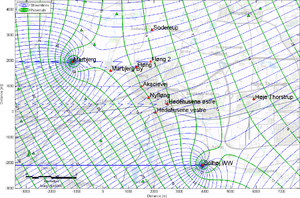Difference between revisions of "Modeling tools"
m |
m |
||
| Line 1: | Line 1: | ||
| − | == | + | == Modeling tools == |
| − | + | === Comsol Multiphysics === | |
| − | |||
* [https://www.comsol.dk Comsol Multiphysics] | * [https://www.comsol.dk Comsol Multiphysics] | ||
| − | + | === FEFlow === | |
* [http://www.mikepoweredbydhi.com/products/feflow FEFlow] | * [http://www.mikepoweredbydhi.com/products/feflow FEFlow] | ||
| − | + | === Hydrogeosphere === | |
* [http://www.aquanty.com/hydrogeosphere HydroGeoSphere] | * [http://www.aquanty.com/hydrogeosphere HydroGeoSphere] | ||
| + | == Useful helpers == | ||
=== Matlab model based on Christ and Goltz, 2002 === | === Matlab model based on Christ and Goltz, 2002 === | ||
Script for calculating the capture zone of wells. Based on the paper by Christ and Goltz, J. Hydrology, 2002, p. 224-244. | Script for calculating the capture zone of wells. Based on the paper by Christ and Goltz, J. Hydrology, 2002, p. 224-244. | ||
| Line 19: | Line 19: | ||
[[File:CaptureZones_Akacievej.png |thumb|none| Example of a capture zone calculation for a field site in Floeng]] | [[File:CaptureZones_Akacievej.png |thumb|none| Example of a capture zone calculation for a field site in Floeng]] | ||
| − | === | + | === Aqtesolv === |
| − | + | Interpretation of slug tests and pump tests | |
| − | |||
| − | |||
| − | |||
| − | |||
| − | |||
| − | |||
| − | |||
| − | |||
| − | |||
| − | |||
| − | |||
| − | |||
| − | |||
| − | |||
| − | |||
| − | |||
| − | |||
| − | |||
| − | |||
| − | |||
| − | |||
| − | |||
Return to [[Main Page | Overview]] | Return to [[Main Page | Overview]] | ||
Revision as of 08:04, 19 April 2016
Contents
Modeling tools
Comsol Multiphysics
FEFlow
Hydrogeosphere
Useful helpers
Matlab model based on Christ and Goltz, 2002
Script for calculating the capture zone of wells. Based on the paper by Christ and Goltz, J. Hydrology, 2002, p. 224-244. [1].
Matlab model for capture zone calculation
Aqtesolv
Interpretation of slug tests and pump tests
Return to Overview
